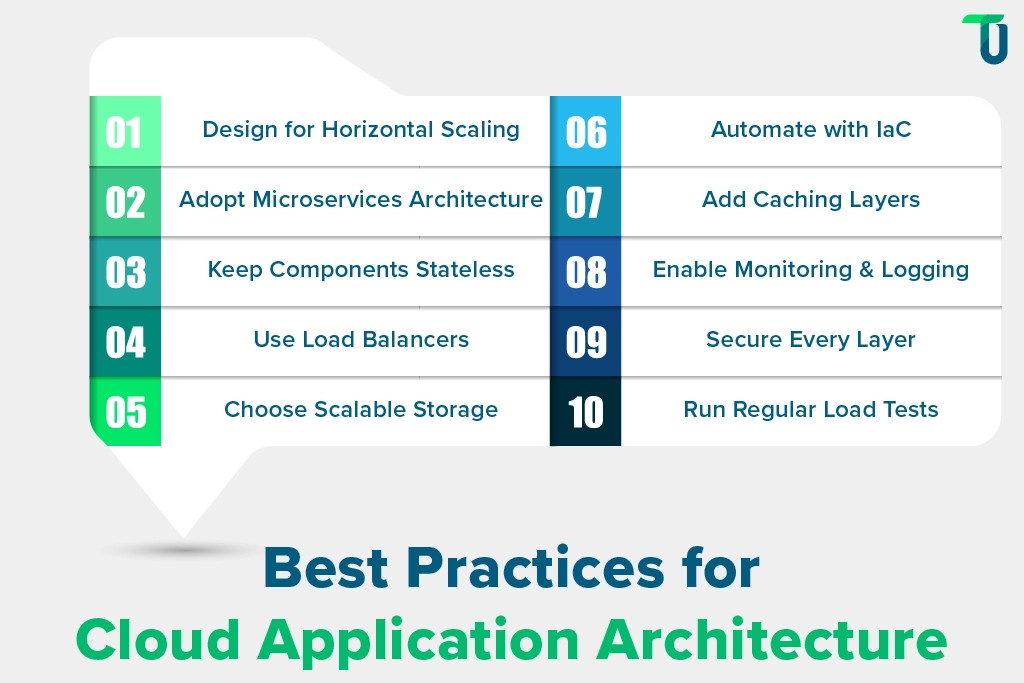Top 10 Best Practices for Cloud Application Architecture
Building a solid cloud application architecture is the first step toward making your app scalable, reliable, and easy to maintain—especially for businesses exploring startup cloud solutions that need flexibility and speed from day one. For insights on overcoming challenges and implementing best practices in cloud-native applications, see Designing Scalable Cloud Architecture. To get it right, you need to think beyond just deploying code. Here are 10 best practices that help you build cloud-native applications ready for real-world use.

1. Design a Cloud Application Architecture for Horizontal Scaling
planning your cloud application architecture, always think ahead, because growth is part of the goal and should be guided by a well-defined cloud native development plan that supports seamless horizontal scaling. Growth is part of the goal, so your design needs to handle more users without slowing down. Horizontal scaling helps you do that by adding more servers instead of trying to upgrade just one. This setup helps your system stay fast and stable, even when traffic suddenly spikes.
Here are the key strategies for horizontal scaling:
Adding more servers: Spread the load across multiple machines rather than relying on one.
Elastic scaling: Use tools like AWS Auto Scaling or Azure Scale Sets to manage scaling automatically, similar to how a maritime ERP system architected with AWS high-availability principles leverages auto-scaling for uninterrupted operations.
Containerization: Platforms like Kubernetes automatically scale containerized apps based on demand.
Improved performance: Your application can scale up or down without losing performance, even during peak traffic.
To summarize, by adopting horizontal scaling, you ensure that your application is both flexible and reliable, even as it grows.
TenUp’s Take: Always design with future scaling in mind. Your app should be able to handle more users by simply adding more servers, not by upgrading a single one. This will keep it stable and fast even as traffic increases.
2. Break Down the Architecture into Microservices
Instead of running one large system, split your application into microservices. Each microservice does a single job and works on its own. In fact, as per a survey, 74% of surveyed organizations have adopted microservices. With microservices, you also avoid breaking the entire system when something fails.
Here’s why microservices are a smart choice:
Smaller codebases: Each service focuses on one function.
Independent scaling: You can scale only the services that need more power.
Easier debugging: Finding and fixing issues takes less time.
Faster updates: You can roll out changes without disturbing the full application.
Better team productivity: Teams can work on separate services at the same time.
This approach supports long-term stability and faster feature releases.
Also Read: Application Architecture Models: Past to Present Evolution
3. Keep Cloud Application Components Stateless
For your application to scale well, the services inside it should be stateless. This means they don’t keep any memory or data from past user requests. Instead, they treat each request as a new one. When your components are stateless, they’re easier to move, restart, or replace.
To design stateless components, follow these basic rules:
Store sessions externally: Use services like Redis to hold login sessions or temporary data.
Avoid local file storage: Keep all files in shared or cloud-based storage.
Design repeatable APIs: Build APIs that can handle requests without needing old context.
Stateless design makes scaling easier and improves recovery when a service crashes.
4. Use Load Balancers to Distribute Traffic
As your app grows, traffic will increase. To manage this traffic evenly, use a load balancer. It sits between users and your servers, directing each request to a healthy server. This avoids overloading a single server and keeps things running smoothly. If one server fails, the load balancer sends traffic to the others. This ensures your users don’t experience downtime.
You must note that most cloud platforms like AWS, Google Cloud, or Azure offer built-in load balancers that are easy to set up. Some can even monitor server health in real time. In short, load balancers help keep your cloud application architecture stable and responsive, especially under pressure.
Also Read: Cloud App Development: AWS vs Azure vs Google Cloud
5. Choose Scalable Storage Solutions
Your application will generate more data as it grows, so your storage must grow with it. You need options that offer flexibility and quick access to data. Traditional storage doesn’t work well here. You want solutions designed for scalability and speed.
Look for storage options like:
Object storage: Store images, backups, and files. Examples include Amazon S3 or Azure Blob.
Distributed databases: Ideal for structured data. Use services like Google Cloud Spanner or DynamoDB.
In-memory caching: For high-speed data access. Redis or Memcached are good choices.
Shared file systems: For persistent storage across multiple servers.
Choosing the right mix keeps your cloud application fast and reliable even as data grows
Maximize Your App's Potential With TenUp
Take the first step in building a scalable cloud architecture. Contact us to guide your cloud transformation.
6. Automate Infrastructure with Infrastructure as Code (IaC)
Managing infrastructure manually is prone to errors and takes time. With Infrastructure as Code (IaC), you define your resources using code files. This approach allows you to deploy, update, or rebuild your cloud environment consistently.
Some of the key benefits of IaC are as follows:
Consistency: Ensure every deployment is the same across all environments.
Change tracking: Easily track updates and roll back when necessary.
Error reduction: Minimize human errors by automating the process.
Collaboration: Multiple teams can manage the same infrastructure setup.
Predictability: Avoid unexpected changes by using code to manage infrastructure.
All in all, this method provides more control while reducing manual work and maintaining consistency in your cloud application architecture — a major driver in how cloud software solutions boost business agility.
7. Integrate Caching into Cloud Application Architecture
Repeatedly accessing the same data slows down your app and increases costs. That’s where caching helps. It stores frequently accessed data in memory, so your app doesn’t need to fetch it from slower storage every time. This leads to faster load times and reduces the strain on your backend systems.
Here’s how caching enhances cloud application architecture:
- Stores frequently used data in memory for quicker access.
- Redis and Memcached can hold session data and repetitive queries.
- CDNs like Cloudflare and AWS CloudFront serve static content faster.
- Reduces latency by serving content from locations closer to the user.
- Improves performance by handling high-volume requests more efficiently.
To encapsulate, integrating caching in your cloud app boosts performance, reduces latency, and optimizes resource utilization.
Expert Advice: While scalability is important, never forget that user experience should always come first. A scalable app is only effective if it delivers a fast and reliable experience to users. Focus on speed, reliability, and security to ensure that users have the best experience, regardless of the app's growth.
8. Enable Monitoring and Logging for Real-Time Visibility
You need a clear picture of what your application is doing. Monitoring and logging provide that visibility. Without them, issues go unnoticed until users complain. Real-time monitoring shows how your systems perform, while logs help find the cause of failures.
Use monitoring and logging to:
Track performance metrics: CPU usage, memory, network traffic.
Get alerts for errors: Catch problems before they impact users.
Analyze patterns: Spot unusual behavior over time.
Debug issues: Review logs to trace errors and fix bugs faster.
Verify deployments: Make sure updates behave as expected.
In addition to these, you should also consider combining tools like Prometheus, Grafana, or the ELK stack to stay on top of your system.
9. Secure All Layers of the Cloud Application Architecture
Security isn't something to add later. Rather, it should be part of your cloud application architecture from the start. In the cloud, risks can show up at many levels, including your network, APIs, users, and third-party integrations. That’s why every layer needs protection, not just the front end.
To build strong security across your system, focus on:
- Limit who can access what. Use multi-factor authentication where possible.
- Protect all data both in transit and at rest. Use strong, up-to-date encryption methods.
- Regularly audit and remove unused roles, keys, or access points.
- Patch software and libraries often to close known vulnerabilities.
- Use features like identity management, automatic key rotation, and activity auditing.
Make these practices part of your routine work. When security is built into your process, it becomes easier to manage, even as your application grows.
10. Perform Load Testing for Scalability Assurance
You won’t know how well your app scales until you test it. Load testing shows what happens when real users start using your app in large numbers. Without it, you risk slow responses or system crashes during peak times. In fact, around 85% of organizations conduct load testing to ensure their applications can handle large volumes of traffic during peak demand periods
Focus your load testing on these areas:
Traffic volume: Simulate different levels of usage.
Performance under stress: Track how response times change as load increases.
Auto-scaling triggers: Confirm if new instances spin up on time.
Backend behavior: Watch how databases and services handle extra load.
Error rates and bottlenecks: Catch slow or failing components.
By following these 10 best practices for cloud application architecture, you can create a fast, scalable, secure, and reliable application that supports high performance and user satisfaction. For deeper insights, explore our guide on best practices for scalable cloud-native architecture to strengthen your cloud strategy even further.
Need Help with Cloud Application Architecture?
Building a scalable cloud application begins with smart strategies—and that starts with selecting the right design scalable cloud architecture to match your business needs and growth plans. A detailed CTO checklist for cloud application development can help you align these strategies with business priorities. By applying the 10 best practices outlined above, you can create an app that’s fast, secure, and capable of growing alongside your users. From setting up horizontal scaling to using load balancers and integrating caching, each step helps you improve performance and reliability.
Looking to implement these strategies but not sure where to start? Let us help! As experts in cloud architecture, we can guide you through every step of the process. Contact us today for a consultation and let’s build a cloud solution tailored to your needs!
Get Expert Help with Your Cloud Architecture
Contact TenUp today for a consultation and create a cloud solution tailored to your needs. Let’s build something great together!
Frequently asked questions
What are the key differences between monolithic and microservices architectures in cloud applications?
Monolithic architecture builds an application as a single, tightly integrated unit, making it simpler to develop initially but harder to scale and maintain. Microservices split the application into independent services, enabling faster development, independent scaling, and better fault isolation. While microservices improve agility and resilience, they add complexity in deployment, communication, and monitoring.
How does containerization benefit cloud application deployment?
Containerization makes cloud deployment faster, more consistent, and scalable by packaging apps with their dependencies into lightweight, isolated units. This ensures reliable performance across environments, streamlines CI/CD, improves resource efficiency, and enables rapid scaling and recovery.
What is the role of orchestration tools like Kubernetes in cloud architecture?
Orchestration tools like Kubernetes automate the deployment, scaling, and management of containerized applications in the cloud. They ensure efficient resource allocation, high availability through load balancing and failover, and seamless communication between services—making cloud applications more reliable, scalable, and easier to manage.
How do Infrastructure as Code (IaC) tools like Terraform and AWS CloudFormation differ?
Terraform is a cloud-agnostic IaC tool supporting multiple providers, offering flexible modules but requiring manual state management. AWS CloudFormation is AWS-specific, with built-in state handling and rollback, simplifying management within AWS environments.
How does a hybrid cloud architecture differ from a multi-cloud strategy?
Hybrid cloud integrates on-premises or private clouds with public clouds for seamless data and app portability. Multi-cloud uses multiple public cloud providers to avoid vendor lock-in, optimize costs, and enhance redundancy.
What are the challenges of migrating legacy applications to the cloud?
Legacy migrations face compatibility gaps, complex data transfers, security risks, and potential downtime. Successful migration requires careful planning, refactoring, and cost management to ensure performance, compliance, and minimal disruption.
How do cost optimization strategies impact cloud application architecture decisions?
Cost optimization guides architecture by promoting resource right-sizing, choosing efficient pricing models, and adopting scalable patterns like serverless and microservices. These strategies reduce waste, lower expenses, and improve performance without compromising scalability.

